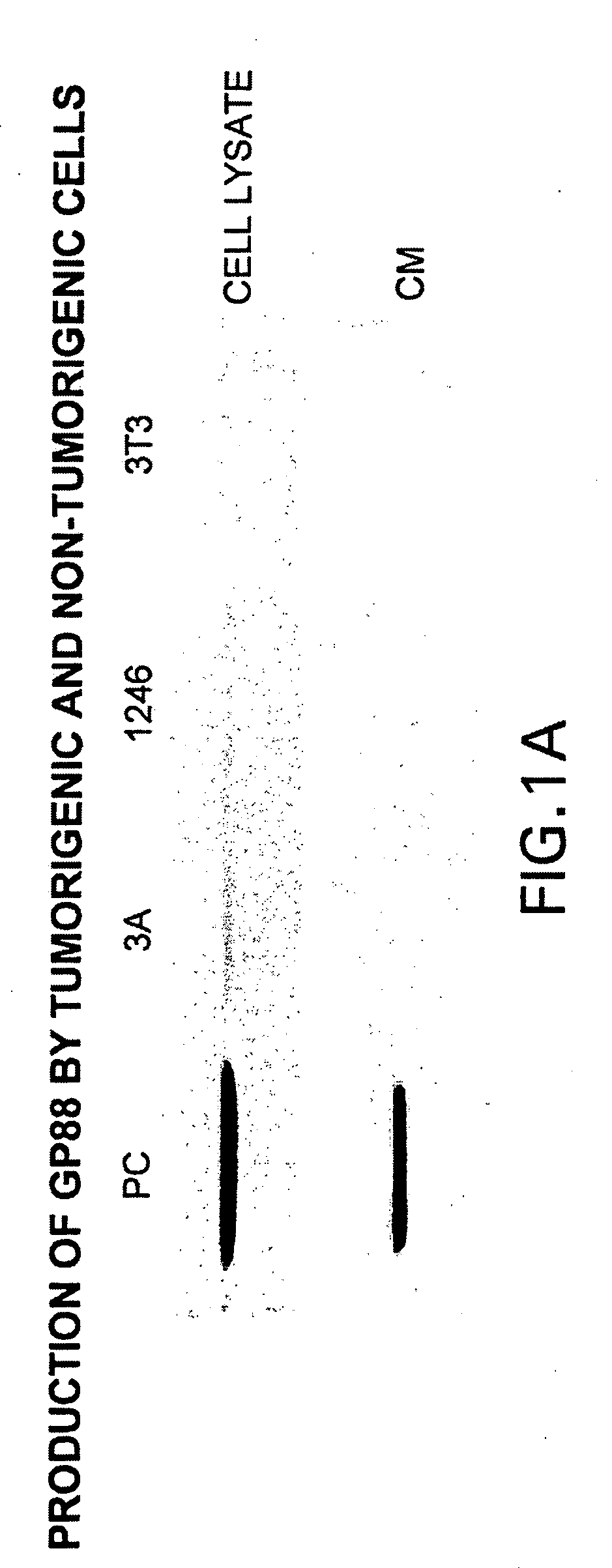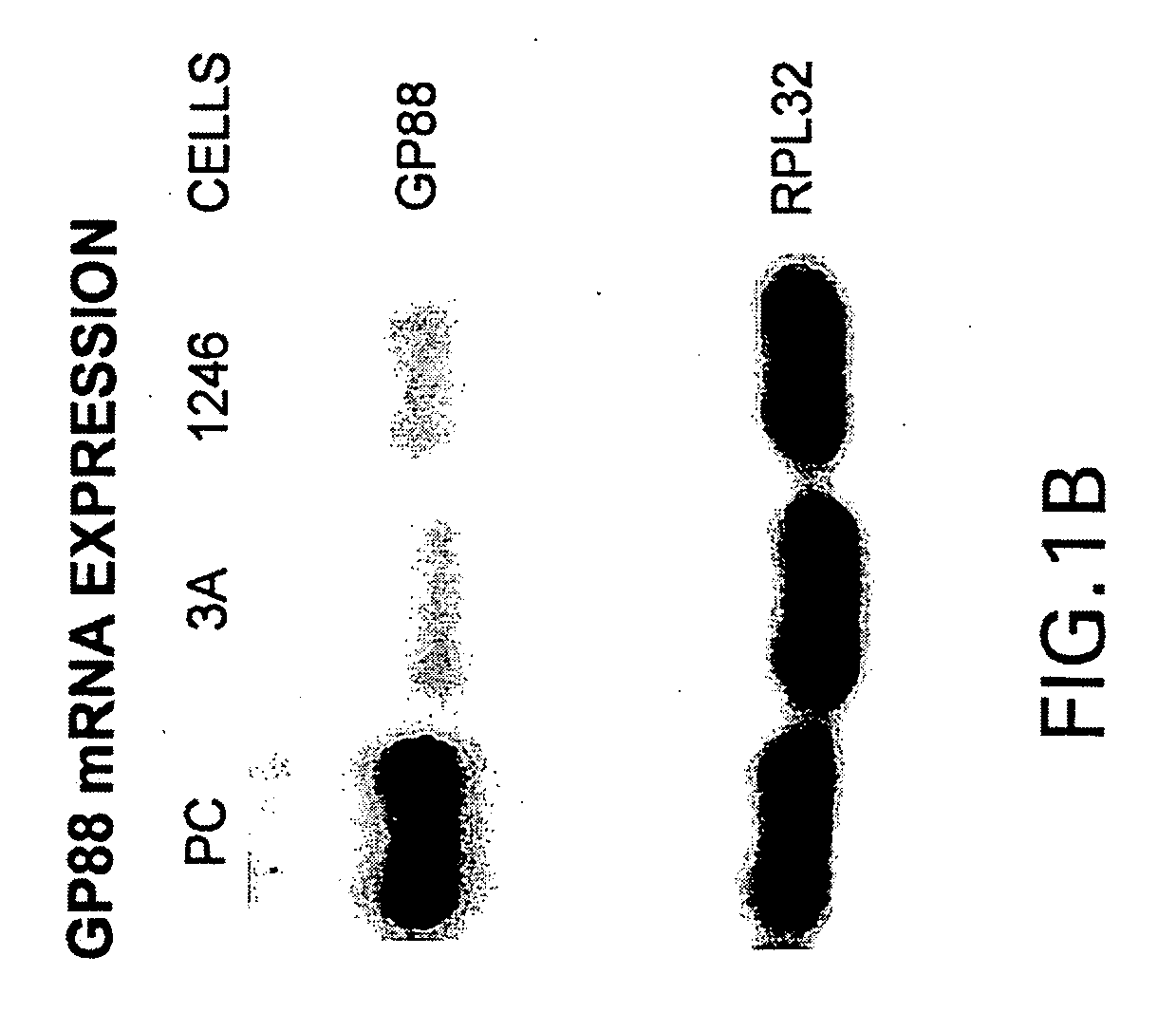88kDa tumorigenic growth factor and antagonists
a growth factor and tumorigenic technology, applied in the field of cell biology, physiology and medicine, can solve the problems of unregulated growth and uncontrolled growth, and achieve the effects of improving the solubility, and reducing the number of tumors
- Summary
- Abstract
- Description
- Claims
- Application Information
AI Technical Summary
Benefits of technology
Problems solved by technology
Method used
Image
Examples
example 1
Isolation of PC Cell Line
[0129]The role of autocrine growth factor production in the loss of differentiation ability and acquisition of tumorigenic properties in mammalian cells has been studied using a murine model system developed by the inventor. It consists of the mouse C3H adipogenic cell line 1246 (9), a series of cell lines which are differentiation-deficient and have increasing tumorigenic properties. 1246 cells proliferate and differentiate in a serum-free defined medium (9). In defined medium, 1246 cells stringently require insulin for proliferation and for differentiation (10). Insulin-like growth factor I (IGF-I) can replace insulin for proliferation but not for differentiation. From 1246 cells maintained in the absence of insulin, insulin-dependent cell lines were isolated (11).
[0130]1246-3A was particularly studied. 1246-3A cells had lost the ability to differentiate and had become tumorigenic in vivo (11). 1246-3A cells formed tumors when 106 cells were injected into ...
example 2
GP88 is an Autocrine Growth Factor for the Highly Tumorigenic PC Cells
[0136]It was shown that PC cell conditioned medium contained growth promoting activity that was purified by chromatographic techniques (4). The purified factor called GP88 precursor was sequenced and shown to be similar to the epithelin / granulin precursor.
[0137]Experiments were then carried out to examine whether the production of GP88 by PC cells stimulated their growth in an autocrine fashion. For this purpose, PC cells were cultivated in the presence of GP88 antibody that can neutralize GP88 activity. DNA synthesis of PC cells was measured in the presence of increasing amounts of either the non-immune IgG or the anti-K19T IgG.
[0138]As shown in FIG. 2, the addition of anti-GP88 IgG inhibited PC cell growth in a dose-dependent manner, directly demonstrating that GP88 production by the PC cells is required for their growth. Non-immune IgG had no effect. Here, PC cells were plated in 96-well plates at a density of ...
example 3
Expression of GP88 in the 1246, 1246-3A and PC Cell Lines
[0140]Since GP88 protein was purified from PC cell conditioned medium, experiments were carried out to compare the expression of GP88 mRNA and protein in the three cell lines.
[0141]Comparative tumorigenicity studies of 1246, 1246-3A and PC cell lines in C3H mice showed that PC cells are highly tumorigenic when compared to 1246-3A cells since they can develop tumors when 104 cells / mouse are injected into C3H mice. 1246-3A cells make tumors when injected a 106 cells / mouse, whereas in syngeneic hosts, 1236 cells are non-tumorigenic (12).
[0142]The following methods were used for the studies of comparing the level of GP88 in the model system consisting of the three cell lines 1246, 1246-3A and PC.
Cell Culture
[0143]1246 stock cells were maintained in DME / F12 nutrient medium (1:1 mixture of Dulbecco's modified Eagle medium and Ham's nutrient F12) supplemented with 10% fetal bovine serum (FBS). 1246-3A and PC stock cells were maintain...
PUM
| Property | Measurement | Unit |
|---|---|---|
| density | aaaaa | aaaaa |
| density | aaaaa | aaaaa |
| pH | aaaaa | aaaaa |
Abstract
Description
Claims
Application Information
 Login to View More
Login to View More - R&D
- Intellectual Property
- Life Sciences
- Materials
- Tech Scout
- Unparalleled Data Quality
- Higher Quality Content
- 60% Fewer Hallucinations
Browse by: Latest US Patents, China's latest patents, Technical Efficacy Thesaurus, Application Domain, Technology Topic, Popular Technical Reports.
© 2025 PatSnap. All rights reserved.Legal|Privacy policy|Modern Slavery Act Transparency Statement|Sitemap|About US| Contact US: help@patsnap.com



